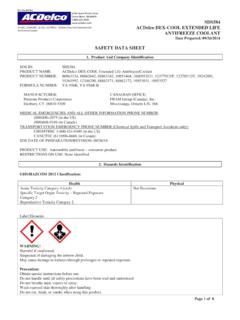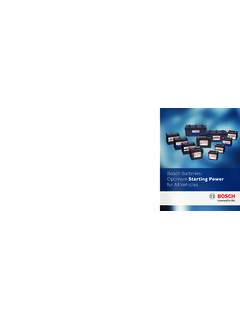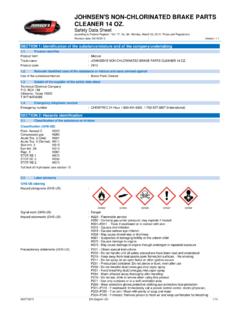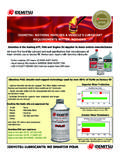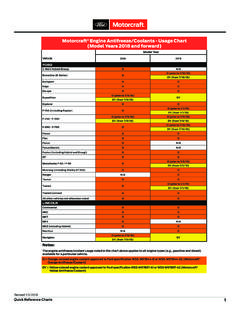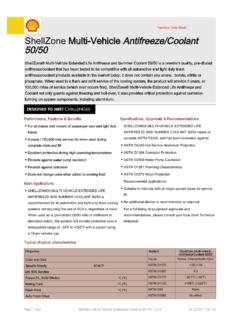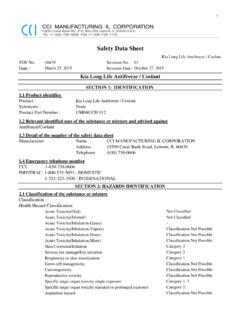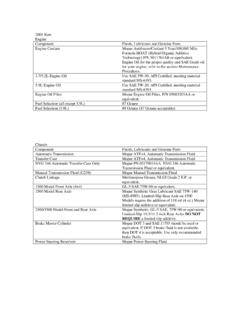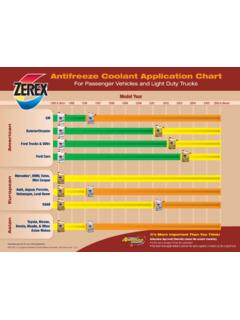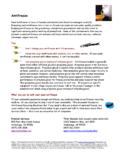Transcription of MATERIAL SAFETY DATA SHEET - WORLDPAC
1 MSDS No. 108247AM Page1 of 6 Date : 10/3/2005 HONDA ALL SEASON antifreeze / coolant TYPE 2 CCI MANUFACTURING IL CORPORATION ADDRESS: 15550 CANAL BANK ROAD BOX 339 LEMONT, IL 60439 PHONE (630) 739-0606 FACSIMILE (630) 739-1116 HONDA ALL SEASON antifreeze / coolant TYPE 2 Emergency Number : Chemtrec : 800/424-9300 General Information : CCI : 630/739-0606 SECTION I - IDENTIFICATION Product : HONDA ALL SEASON antifreeze / coolant TYPE 2 Synonyms : Long Life coolant L247A 50% Chemical Family : Ethylene Glycol solution of salts Cas RN : Mixture - no single Cas number applicable SECTION II - INGREDIENTS Components Cas RN Nominal % HazardCode PEL/TLV Hazard Ethylene Glycol 107-21-1 47 - 53% A Ceiling: 50 ppm (125 mg/m) [vapor and Mist] Respiratory irritant Ingestion may produce liver, brain and kidney damage.
2 Diethylene Glycol 111-46-6 Less than 3%A None Ingestion may produce liver and kidney damage. Potassium Hydroxide 1310-58-3 Less than 3%A PEL-TWA : 2 mg/m3 TLV-TWA : 2 mg/m3 Skin, eye and respiratory irritant. GI tract salts inflammation. Hydrated inorganic acid, organic acid salts pro- prietary Less than 5%N/A None None noted Water 7732-18-5 40 - 50% N/A None None noted Bittering agent pro- prietary >30mg/kg A Not established Skin, eye and respiratory irritant MATERIAL SAFETY DATA SHEET MANUFACTURING IL CORPORATIONMSDS No.
3 108247AM Page2 of 6 Date : 10/3/2005 HONDA ALL SEASON antifreeze / coolant TYPE 2 SECTION III - HEALTH INFORMATION Inhalation : Breathing excessive levels of the vapor or mist can irritate the respiratory tract. Excessive vapor concentrations of the major component (ethylene glycol), as might be generated during heating of this MATERIAL , have occasionally been reported to cause adverse effects on the blood-forming system and the nervous system. Ingestion : The acute oral toxicities of the components of this mixture are as follows : Ethylene Glycol : The lowest dose reported to produce death in humans was estimated to be 710 mg/kg body weight; for a person weighing 150 pounds, this would be equivalent to drinking about one and one-half ( ) fluid ounces of pure ethylene glycol in a short period of time.
4 Acute oral LD50's = 4,700 mg/kg (rats) 7,500 mg/kg (mice) 2,000 mg/kg (cats) Potassium Hydroxide : Acute oral LD50's= 365 mg/kg (rats) Diethylene glycol : Acute oral LD50's = 1,000 mg/kg (humans) 14,800 mg/kg (rats) 9,000 mg/kg (dogs) Eye Contact : . Based on the pH and irritation potential of this mixture s constituents, the mist or liquid can be expected to cause mild to moderate irritation or inflammation of the eyes Skin Contact : The acute dermal LD50 of the major component (ethylene glycol) of this product is g/kg(rabbits). Based on the pH and the irritation potential of this mixture s constituents, the mist or liquid can be expected to cause mild to moderate irritation of the skin.
5 IARC : ( ) OSHA : ( ) NTP : ( ) Not listed : ( X ) Carcinogenicity Listing SECTION IV - OCCUPATIONAL EXPOSURE LIMITS PEL (OSHA Permissible Exposure Limit) : None established for mixture, See Section II. TLV (ACGIH Threshold Limit Value) : None established for mixture, See Section II. SECTION V - EMERGENCY FIRST AID PROCEDURE For Overdose Exposure By : Swallowing : If victim is conscious and able to swallow, quickly have victim drink water or milk to dilute. Do NOT give sodium bicarbonate, fruit juices or vinegar. NEVER give anything by mouth if victim is unconscious or having convulsions. Induce vomiting only if advised by physician or Poison Control Center. CALL PHYSICIAN OR POISON CONTROL CENTER IMMEDIATELY.
6 MSDS No. 108247AM Page3 of 6 Date : 10/3/2005 HONDA ALL SEASON antifreeze / coolant TYPE 2 SECTION V - EMERGENCY FIRST AID PROCEDURE (CONTINUED) Skin Contact : Immediately flush skin with plenty of water while removing contaminated clothing. Eye Contact : Immediately flush eyes with plenty of cool water for at least 15 minutes. Do NOT permit victim to rub eyes. GET MEDICAL ATTENTION IMMEDIATELY. Inhalation : Immediately remove victim to fresh air. If victim has stopped breathing give artificial respiration, preferably mouth-to-mouth. GET MEDICAL ATTENTION IMMEDIATELY. SECTION VI - PHYSICAL DATA Boiling Point : Higher than 226 F Melting Point : (Freezing Point) lower than -34 F Vapor Pressure : Not determined Density (20C) : g/cm3 Vapor Density (AIR = 1) : Not determined pH (Original) : Solubility in Water : Infinite miscibility Appearance and Color : Clear, slightly viscous, Dark blue liquid SECTION VII - FIRE AND EXPLOSION HAZARDS Flash Point : None Auto-Ignition Temperature : Not determined (752 F for ethylene glycol) Flammable Limits in Air, %by Vol.
7 Lower : Upper : Not determined ( for ethylene glycol) Not determined ( for ethylene glycol) NFPA Rating : Health ( 1 ) Fire ( 0 ) Reactivity ( 0 ) Fire Fighting Procedures : (Note: Individuals should perform only those firefighting procedures for which they have been trained.) Use water spray, dry chemical, foam or carbon dioxide. Use water to keep fire-exposed containers cool. If a spill or leak has not ignited, use water spray to disperse the vapors. Water spray may be used to flush spills away from fire and diluted spills to noncombustible proportions (see warning on water spray on hot glycol below).
8 Unusual Fire & Explosion Hazards : Fire fighters should wear self-contained breathing apparatus in the positive pressure mode with a full face piece when, there is a possibility of exposure to smoke, fumes or hazardous decomposition products. Water spray may cause foaming of hot glycol so indirect application of water spray or use of other extinguishing media should be used on hot glycol. MSDS No. 108247AM Page4 of 6 Date : 10/3/2005 HONDA ALL SEASON antifreeze / coolant TYPE 2 SECTION VIII - REACTIVITY Stability : Generally stable Hazardous Polymerization : Not likely to occur Conditions and Materials to Avoid: Avoid concentrated strong acids, oxidizing agents and bases. Do not expose to open flame.
9 Hazardous Decomposition Products : If pyrolyzed, thermal decomposition products of residue may include C, CO, CO2, H2O, NH3, organic vapors and nitrogen-containing. SECTION IX - EMPLOYEE PROTECTION Control Measures : Handle in the presence of adequate ventilation. Engineering controls should be used whenever feasible to maintain concentrations below acceptable exposure criteria (see Section II and IV), including enclosures and local exhaust ventilation. Respiratory Protection : Where exposure is likely to exceed acceptable criteria (see Section II and IV) and engineering controls are not feasible, use NOSH/MISHA approved respiratory protection equipment. Respirators should be selected based on the form and concentration of contaminants in air and in accordance with OSHA (29 CFR ).
10 Protective Clothing : Wear gloves and protective clothing which are impervious to the product for the duration of exposure if there is potential for skin contact. Eye Protection : Wear SAFETY glasses meeting the specifications of ANSI standard where no contact with the eye is anticipated. Chemical SAFETY goggles meeting the specification of ANSI Standard should be worn whenever there is the possibility of splashing or other contact with the eyes. SECTION X - ENVIRONMENTAL PROTECTION Environmental Precautions : Avoid uncontrolled releases of this MATERIAL . Where spills are possible, a comprehensive spill release response plan should be developed and implemented. Spill or Leak Procedures: Wear appropriate respiratory equipment and protective equipment as described in Section IX.
